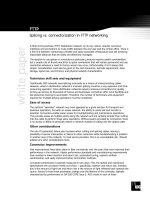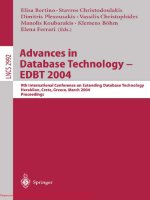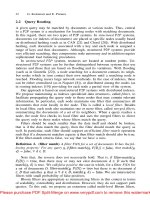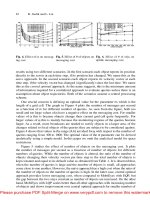Advances in communication networking 20th EUNICE IFIP EG 6 2, 6 6 international workshop
Bạn đang xem bản rút gọn của tài liệu. Xem và tải ngay bản đầy đủ của tài liệu tại đây (14.88 MB, 237 trang )
LNCS 8846
Yvon Kermarrec (Ed.)
Advances
in Communication
Networking
20th EUNICE/IFIP EG 6.2, 6.6 International Workshop
Rennes, France, September 1–5, 2014
Revised Selected Papers
123
Lecture Notes in Computer Science
Commenced Publication in 1973
Founding and Former Series Editors:
Gerhard Goos, Juris Hartmanis, and Jan van Leeuwen
Editorial Board
David Hutchison
Lancaster University, Lancaster, UK
Takeo Kanade
Carnegie Mellon University, Pittsburgh, PA, USA
Josef Kittler
University of Surrey, Guildford, UK
Jon M. Kleinberg
Cornell University, Ithaca, NY, USA
Friedemann Mattern
ETH Zurich, Zürich, Switzerland
John C. Mitchell
Stanford University, Stanford, CA, USA
Moni Naor
Weizmann Institute of Science, Rehovot, Israel
C. Pandu Rangan
Indian Institute of Technology, Madras, India
Bernhard Steffen
TU Dortmund University, Dortmund, Germany
Demetri Terzopoulos
University of California, Los Angeles, CA, USA
Doug Tygar
University of California, Berkeley, CA, USA
Gerhard Weikum
Max Planck Institute for Informatics, Saarbruecken, Germany
8846
More information about this series at />
Yvon Kermarrec (Ed.)
Advances
in Communication
Networking
20th EUNICE/IFIP EG 6.2, 6.6
International Workshop
Rennes, France, September 1–5, 2014
Revised Selected Papers
123
Editor
Yvon Kermarrec
Institut Mines Telecom
École National Supérieure des
Télécommunications
Brest Cedex
France
ISSN 0302-9743
ISSN 1611-3349 (electronic)
Lecture Notes in Computer Science
ISBN 978-3-319-13487-1
ISBN 978-3-319-13488-8 (eBook)
DOI 10.1007/978-3-319-13488-8
Library of Congress Control Number: 2014956528
LNCS Sublibrary: SL3 – Information Systems and Applications, incl. Internet/Web, and HCI
Springer Cham Heidelberg New York Dordrecht London
© Springer International Publishing Switzerland 2014
This work is subject to copyright. All rights are reserved by the Publisher, whether the whole or part of the
material is concerned, specifically the rights of translation, reprinting, reuse of illustrations, recitation,
broadcasting, reproduction on microfilms or in any other physical way, and transmission or information
storage and retrieval, electronic adaptation, computer software, or by similar or dissimilar methodology now
known or hereafter developed.
The use of general descriptive names, registered names, trademarks, service marks, etc. in this publication
does not imply, even in the absence of a specific statement, that such names are exempt from the relevant
protective laws and regulations and therefore free for general use.
The publisher, the authors and the editors are safe to assume that the advice and information in this book are
believed to be true and accurate at the date of publication. Neither the publisher nor the authors or the editors
give a warranty, express or implied, with respect to the material contained herein or for any errors or
omissions that may have been made.
Printed on acid-free paper
Springer International Publishing AG Switzerland is part of Springer Science+Business Media
(www.springer.com)
Preface
The 20th edition of the EUNICE summer school and conference is part of a series of
annual international conferences devoted to the promotion and advancement of all
aspects of Information and Communication Technologies. The main objective of these
events is to provide a forum to promote educational and research cooperation between
its member institutions and foster the mobility of students, faculty members, and
research scientists working in the field of information and communication technologies.
This edition marked a return to France by selecting the splendid venue of Brittany, a
region marked by its history with a strong Celtic tradition and a remote location at the
western tip of the EU continent that was the initiator of many innovations and disruptive technologies in the telecommunication and network domains. Télécom Bretagne was the location of the very first edition of the events back in 1994 and we are
proud to celebrate the 20th edition.
Following its usual style, the conference included a three-day technical program,
where the papers contained in these proceedings were presented. Papers were received
from various parts of Europe and the EUNICE community. The technical program was
then followed by two tutorial days where attendants had the opportunity to catch up on
issues related to new trends in software engineering for telecommunication and big
data.
The conference features three distinguished keynote speakers, who delivered stateof-the-art information on related topics of great importance, both for the present and
future of telecommunication systems:
– Prosper Chemouil, from Orange Labs, delivered a talk on “Network management
trends for future networks.”
– Nora and Frédéric Cuppens, from Institut Mines Télécom, delivered a talk on
“Multilevel response systems to maintain information in optimal security
Conditions.”
We would like to express our sincere gratitude to these distinguished speakers for
sharing their insights and views with the conference participants.
The conference also included an interesting selection of tutorials, featuring wellknown experts, who presented introductory and advanced material in the scope of the
conference and summer school:
– Vanea Chiprianov, from Université de Pau, France, gave a tutorial on “How modeling techniques can address new service creation and deal with complexity.”
– Emmanuel Bertin, from Orange Labs in Caen, France, continued this previous
tutorial with “New services: an IT and operator view.”
– Erwan Le Merrer, from Technicolor, Rennes, France gave a tutorial on big data
issues: “Storage + processing: data crunching at the big data age.”
VI
Preface
We wish to extend our gratitude to these experts, for the work they put in preparing
and presenting these contents during the summer school, and for their dedication to
train PhD students to these challenging domains.
The 20th edition of the EUNICE conference and summer school was made possible
through the generous support of “Conseil Régional de Bretagne” and “Institut Mines
Télécom.” Their names and logos appear on the conference web site.
We would like to thank the effort and contribution of the Technical Program
Committee for their careful and precise reviews of the submitted papers, and for the
insightful comments they provided to the authors, guidance for their future work, and
suggestion to improve their research. EasyChair was used throughout the various
phases of the conference calls and proceedings and we did appreciate this great support
environment.
The organization committee was led by Mrs. Ghislaine Le Gall, who coordinated
and worked very hard to make the conference a success and in helping us with the
intricate and complex details of the organization.
Finally, we also thank the authors of the contributions submitted to the conference,
and all the participants who helped in achieving the goal of the conference: to provide a
forum for young researchers for the exchange of information and ideas about ICT. We
hope they all enjoyed the program as well as the social events of the 20th edition of the
EUNICE conference and summer school.
August 2014
Yvon Kermarrec
Organization
Program Committee
Finn Arve Aagesen
Thomas Bauschert
Alberto Blanc
Jean Marie Bonnin
Rolv Braek
Ana Cavalli
Vanea Chiprianov
Joerg Eberspaecher
Annie Gravey
Martin Heusse
Yvon Kermarrec
Thomas Knoll
Paul J. Kuehn
Ralf Lehnert
Miquel Oliver
Laurent Pautet
Aiko Pras
Peter Reichl
Sebastia Sallent
Robert Szabo
Norwegian University of Science and Technology,
Norway
TU Chemnitz, Germany
Télécom Bretagne, France
Télécom Bretagne, France
Norwegian University of Science and Technology,
Norway
GET/INT, France
Université de Pau, France
Technische Universität München, Germany
Télécom Bretagne, France
ENSIMAG, France
GET/ENST Bretagne, France
TU Chemnitz, Germany
University of Stuttgart/IKR, Germany
TU Dresden, Germany
Universitat Pompeu Fabra, Spain
Télécom ParisTech, France
University of Twente, The Netherlands
Universität Wien, Austria
Universitat Politècnica de Catalunya, Spain
Budapest University of Technology and
Economics, Hungary
Additional Reviewers
Domingo, Mari Carmen
Landmark, Lars
Metzger, Florian
Nguyen, Huu Nghia
Øverby, Harald
Radeke, Rico
Remondo, David
Richter, Volker
Rincon, David
Rivera, Diego
Robles, Jorge
Santanna, Jair
Schmidt, Ricardo
Toumi, Khalifa
Contents
An Orchestrator-Based SDN Framework with Its Northbound Interface . . . . .
Amin Aflatoonian, Ahmed Bouabdallah, Vincent Catros, Karine Guillouard,
and Jean-Marie Bonnin
A Tabu Search Optimization for Multicast Provisioning in Mixed-Line-Rate
Optical Networks . . . . . . . . . . . . . . . . . . . . . . . . . . . . . . . . . . . . . . . . . .
Mohamed Amine Ait-Ouahmed and Fen Zhou
Consensus Based Report-Back Protocol for Improving the Network
Lifetime in Underwater Sensor Networks . . . . . . . . . . . . . . . . . . . . . . . . . .
Ameen Chilwan, Natalia Amelina, Zhifei Mao, Yuming Jiang,
and Dimitrios J. Vergados
Merging IEC CIM and DMTF CIM – A Step Towards an Improved
Smart Grid Information Model . . . . . . . . . . . . . . . . . . . . . . . . . . . . . . . . .
Kornschnok Dittawit and Finn Arve Aagesen
How Much LTE Traffic Can Be Offloaded? . . . . . . . . . . . . . . . . . . . . . . . .
Souheir Eido and Annie Gravey
Approaches for Offering QoS and Specialized Traffic Treatment
for WebRTC . . . . . . . . . . . . . . . . . . . . . . . . . . . . . . . . . . . . . . . . . . . . .
Ewa Janczukowicz, Stéphane Tuffin, Arnaud Braud, Ahmed Bouabdallah,
Gaël Fromentoux, and Jean-Marie Bonnin
1
14
26
38
48
59
Identifying Operating System Using Flow-Based Traffic Fingerprinting . . . . .
Tomáš Jirsík and Pavel Čeleda
70
Towards an Integrated SDN-NFV Architecture for EPON Networks . . . . . . .
Hamzeh Khalili, David Rincón, and Sebastià Sallent
74
Towards Validation of the Internet Census 2012 . . . . . . . . . . . . . . . . . . . . .
Dirk Maan, José Jair Santanna, Anna Sperotto, and Pieter-Tjerk de Boer
85
Development and Performance Evaluation of Fast Combinatorial
Unranking Implementations . . . . . . . . . . . . . . . . . . . . . . . . . . . . . . . . . . .
András Majdán, Gábor Rétvári, and János Tapolcai
97
YouQoS – A New Concept for Quality of Service in DSL Based
Access Networks. . . . . . . . . . . . . . . . . . . . . . . . . . . . . . . . . . . . . . . . . . .
Sebastian Meier, Alexander Vensmer, and Kristian Ulshöfer
109
X
Contents
Compressing Virtual Forwarding Information Bases Using the Trie-folding
Algorithm . . . . . . . . . . . . . . . . . . . . . . . . . . . . . . . . . . . . . . . . . . . . . . .
Bence Mihálka, Attila Kőrösi, and Gábor Rétvári
Survey on Network Interface Selection in Multihomed Mobile Networks . . . .
Pratibha Mitharwal, Christophe Lohr, and Annie Gravey
Mercury: Revealing Hidden Interconnections Between Access ISPs
and Content Providers . . . . . . . . . . . . . . . . . . . . . . . . . . . . . . . . . . . . . . .
Manuel Palacin, Alex Bikfalvi, and Miquel Oliver
Malleability Resilient Concealed Data Aggregation . . . . . . . . . . . . . . . . . . .
Keyur Parmar and Devesh C. Jinwala
Aligned Beacon Transmissions to Increase IEEE 802.11s Light Sleep
Mode Scalability . . . . . . . . . . . . . . . . . . . . . . . . . . . . . . . . . . . . . . . . . . .
Marco Porsch and Thomas Bauschert
Evaluation of ARED, CoDel and PIE . . . . . . . . . . . . . . . . . . . . . . . . . . . .
Jens Schwardmann, David Wagner, and Mirja Kühlewind
Analysis of the YouTube Server Selection Behavior Observed in a Large
German ISP Network . . . . . . . . . . . . . . . . . . . . . . . . . . . . . . . . . . . . . . .
Gerd Windisch
121
134
147
160
173
185
192
On the Computational Complexity of Policy Routing . . . . . . . . . . . . . . . . .
Márton Zubor, Attila Kőrösi, András Gulyás, and Gábor Rétvári
202
Detection of DNS Traffic Anomalies in Large Networks . . . . . . . . . . . . . . .
Milan Čermák, Pavel Čeleda, and Jan Vykopal
215
Author Index . . . . . . . . . . . . . . . . . . . . . . . . . . . . . . . . . . . . . . . . . . . .
227
An Orchestrator-Based SDN Framework with
Its Northbound Interface
Amin Aflatoonian1,2(B) , Ahmed Bouabdallah2 , Vincent Catros1 ,
Karine Guillouard1 , and Jean-Marie Bonnin2
1
Orange Labs, Rennes, France
{amin.aflatoonian,vincent.catros,karine.guillouard}@orange.com
2
TELECOM Bretagne, Cesson S´evign´e, France
{amin.aflatoonian,ahmed.bouabdallah,jm.bonnin}@telecom-bretagne.eu
Abstract. Software Defined Networking (SDN) is deemed to empower
next generation network and cloud services in several aspects. The authors
argue that its high flexibility can be exploited not only in retrieving
services efficiently but also in yielding new ones by introducing programming capabilities on its top. This however requires to structure its
northbound interface (NBI) with an abstract application programming
interface (API), the definition of which is actually one of the SDN
challenges.
We propose in this paper a global analysis of the capabilities of the
NBI of the SDN articulated to a generic but simple double sided model of
service lifecycle. Its analysis determines interesting properties of the NBI
leading to precisely identify the associated API. We derive from this service lifecycle a general framework structuring the internal architecture of
the SDN in two orchestrators dedicated respectively to the management
of services and resources. Our approach which provides a firm foundation
for the implementation of the NBI is illustrated with an example.
Keywords: Software Defined Networking (SDN) · Service orchestrator ·
Northbound Interface (NBI) · SDN framework
1
Introduction
Nowadays Internet whose number of users approaches 2,7 billions [20], is massively used in all human activities from the professional part to the private ones
via academical ones, administrative ones, etc. The infrastructure supporting the
Internet services rests on various interconnected communication networks managed by network operators. This continuously growing infrastructure evolves
very dynamically and becomes quite huge, complex, and sometimes locally ossified. To configure and maintain their communication networks and provide highlevel services, network operators have therefore to deal with a large number of
routers, firewalls, switches and various heterogeneous devices with a progressively
reduced lifecycle due to the fast hardware and software changes. This growing
complexity makes the introduction of a new service or a new protocol together
c Springer International Publishing Switzerland 2014
Y. Kermarrec (Ed.): EUNICE 2014, LNCS 8846, pp. 1–13, 2014.
DOI: 10.1007/978-3-319-13488-8 1
2
A. Aflatoonian et al.
with its configuration, an exceptionally difficult task, because network operators
have to translate a high-level service specification to low-level distributed device
configurations and next to configure these ones through their command line
interface (CLI). This introduction have non trivial side effects leading to frequent network state changes for which operators have to adapt manually the
existing network configuration to integrate the new services or protocols. As a
result, this manual configuration may lead to frequent misconfigurations [16].
Last but not least, all these may have an adverse effect on the management cost
of the operator (OPEX).
One of the main origins of the problem comes from the heterogeneous, decentralized and proprietary based control plane of the network. Indeed, each network
device usually merges the control and the data plane in a proprietary box. Moving the control function out of the data plane element leads to an interesting two
layer-based architecture. The potential benefits of such a separation have been
explored in many previous studies. The 4D architecture [13], for example, separates completely an Autonomous System (AS) decision logic from the protocols
governing the interactions among network elements. In this approach the routers
and switches simply forward packets. This principle of decorrelating the control
plane from the data one has indeed many advantages: it allows each one to evolve
independently and with a high flexibility, moreover the vendor-agnostic control
plane is programmable and provides a centralized network view. This approach
leads to the development of a new promising network paradigm called Software
Defined Networking (SDN) exploiting such a separation [17].
The main benefits brought by SDN rest on the centralized implementation of the entity managing the control plane which is usually called network
controller [21]. Its interacting capabilities with the controlled network devices
are done through the southbound interface (SBI) and have several advantages.
Firstly, the programmability of the network straightforwardly follows from its
centralized nature. It is clear that the introduction of new changes in the network through a program is easier than manually modifying the network using
proprietary CLI of heterogeneous network devices. Secondly, observing the global
network state, in a centralized way, allows the setting-up of precious knowledge
exploited by the management program to optimize network traffic forwarding
decisions. Nowadays, numerous commercial and non-commercial communities
are developing SDN controllers, e.g. Controllers such as NOX [14], Beacon [12],
Maestro [9], Floodlight [4], OpenDayLight [6]. It is worth noting that OpenFlow
[19], proposed by Open Networking Foundation (ONF) [1], is the only standardized protocol implementing the SBI. Another interesting feature of the SDN concerns the capability to provide to third party applications an abstract view of the
forwarding plane and of the network state. By interacting with different network
devices, the controller may extract information and present through the northbound interface (NBI) an abstract view to network applications, such as load
balancing and VLAN provisioning. This interface permits a rich synergy between
the network and its applications. Network applications may conversely use the
network abstraction to achieve the desired network behavior without knowledge
An Orchestrator-Based SDN Framework
3
of detailed physical network configuration. Supplying network information to
the application, in order to reduce transition costs while improving applications
performance, was proposed by the P4P framework [22]. In order to provide a network abstraction view, the IETF standardized a protocol for Application Layer
Traffic Optimization (ALTO) [3]. The abstracted view is provided by the map
of network regions and a ranking for connections between them. The work [15],
also proposes the use of ALTO as a source of network topology and information
to manipulate network state.
It is clear that, on one hand, an SDN based network management by significantly reducing the workload of network configurations, directly improves the
operator’s OPEX and CAPEX (Capital expenditure). On the other hand, we
argue that the full potential of SDN is far from being reached specially when considering the actually unexploited capabilities associated to the NBI. Indeed, in all
the existing SDN controllers implementation [4,6,9,12,14] in order to make some
modifications in the underlying network, an application (e.g. clients, orchestrators, admin, etc.) pushes some parameters via a REpresentational State Transfer (REST) interface into the NBI of the SDN controller. In order to govern the
underlying network, existing controllers benefit a set of application blocks implementing basic network functions such as topology manager, switch manager, etc.
To implement a service on an SDN based network, operators face a large number
of controllers each one using a specific configuration work flow. This diversity of
accesses to controllers through NBI prevents pooling processes which are fundamentally the same management tasks, if we consider them with the correct
abstraction. It means that we finally moved from heterogeneous proprietary network devices to a miscellaneous SDN controllers world. It appears that providing
a service abstraction on the top of the SDN controller may directly improve the
network management. Nowadays, developing the right abstractions is one of the
SDN challenges. This problematic has at our knowledge been once addressed by
Tail-F who proposes a partial proprietary solution [10]. In order to reduce the
Operation Support System (OSS) cost and also the time-to-market of services,
Tail-F Network Control System (NCS) [2] introduces an abstraction layer on the
top of the NBI in order to implement different services, including layer 2 or layer
3 VPN. It addresses an automated chain from the service request, on one hand,
to the device configuration deployment in the network, on the other hand. This
solution uses the YANG data model [8] in order to transform the informal service
model to a formal one. The service model is mapped into device configurations
as a data model transformation. The proposed work doesn’t however cover all
management phases of the service lifecycle, specially service monitoring, maintenance, etc. Due to the proprietary nature of this product it is not possible to
precisely analyze its internal structure.
We present in this paper a comprehensive solution to this problematic by
identifying a reasonable set of capabilities of the NBI of the SDN together with
the associated Application Programming Interfaces (API). Our first contribution
rests on a global analysis of an abstract model of the operator platform articulated to a generic but simple service lifecycle, described in Sect. 2, which takes
4
A. Aflatoonian et al.
into account the view of the user together with that of the operator. Tackling
the service lifecycle following these two sides simplifies the service abstraction
design. The first viewpoint allows us to identify the APIs structuring the NBI and
shared by both actors (operator and service consumer). By analyzing the second
viewpoint we determine a model of the operator platform based on SDN which
constitutes our second contribution. This platform model is abstracted through a
framework involving a minimal set of functions required to manage any network
service. We organize this set of functions in two orchestrators, one dedicated
exclusively to the management of the resources: the resource orchestrator, and
the other one grouping the remaining functions: the service orchestrator. The
general framework structuring the internal architecture of SDN is presented in
Sect. 3 and illustrated with an example. This framework is externally limited by
NBI and SBI and internally clarifies the border between the two orchestrators
by identifying an internal interface between them, called the middle interface.
Finally, in the Sect. 4 we conclude the paper and outline some future works.
2
SDN Service LifeCycle Analysis
The ability of managing the lifecycle of a service is essential to implement it in an
operator platform. Existing service lifecycle frameworks are oriented on humandriven services. For example, if a client needs to introduce or change an existing
service, the operator has to configure the service manually. This manual configuration may take hours or sometimes days. It may therefore significantly affect
the operators OPEX. It clearly appears that the operator has to re-think about
its service implementation in order to provision dynamically and also to develop
on-demand services. There are proposals in order to enhance new on-demand network resource provisioning. For instance, the GYESERS project [11], proposed a
complex service lifecycle model for on-demand service provisioning. This model
includes five typical stages, namely service requests/Service Level Agreement
(SLA) negotiation, composition/reservation, deployment/register and synchronization, operation (monitoring), decommissioning. The main drawback of this
model rests on its inherent complexity. We argue this one may be reduced by
splitting the global service lifecycle in two complementary and manageable view
points: client and operator view. Each one of both views captures only the information useful for the associated actor. The global view may however be obtained
by composing the two partial views. We present below a detailed description of
these two views together with the associated global view.
2.1
The Client View
Client-Side Service Lifecycle. The client-side service lifecycle is illustrated
in Fig. 1. This service lifecycle consists of four main steps:
– Service creation: The client specifies the service characteristics she needs, she
negotiates the associated SLA which will be available for limited duration and
finally she requests a new service creation.
An Orchestrator-Based SDN Framework
5
Fig. 1. Client-side service lifecycle
– Service monitoring: Once created, the service may be used by the client for
the negotiated duration. The service consummation which concerns the client’s
work-flow induces it’s monitoring with statistics production in order to control
its exploitation.
– Service modification: The client may request the modification of some parts
of the existing service because of a new need. Its treatment is globally similar
to the service creation request.
– Service update: The management of the operator’s network may lead to the
update of the service which can be issued because of a problem occurring
during the service consummation or a modification of the network infrastructure. This update may be minimal or it may impact the previous steps, with
consequences on the service creation and/or on the service consummation.
– Service retirement: The client retires the service at the end of the negotiated
duration. This step defines the end of the service life.
The Northbound Interface. The client-side service lifecycle is carried with
interactions between the client’s service portal and the operator platform through
the northbound interface (NBI). Our approach generalizes the classical SDN one
where the NBI defines the interface which interconnects the client-side application
with the SDN controller [17,21].
Figure 2 gives an overview of the communication between the service portal and the operator system through the NBI. This communication is divided
in two main types: top-down and bottom-up, each one composed of requests
acknowledged by responses or of notifications.
– Top-down communication rests on a set of messages initiated from the service
portal to the operator system. This message family includes service creation,
modification, retirement and monitoring requests.
– Bottom-up communication consists of a set of update notifications and update
request messages initiated from the operator system to the service portal. An
6
A. Aflatoonian et al.
Fig. 2. Client-side service control
update notification allows to inform the client while an update request message
should alter the current behavior of the service.
Figure 2 presents detailed steps of a generic call flow involving all the clientside service lifecycle.
1. In the first step the client requests a new service creation or a modification
of an existing one. This step will ended with a response occurring when the
service is implemented in the operator’s platform.
2. During the service consummation phase, the client may request the monitoring of the service. A service update initiated by the operator may also
happen. If this update is minor it just leads to a service update notification.
Otherwise, it may trigger a service update request sent to the client, as for
example for an update of the operator’s network (software, hardware, etc.).
The client acknowledges it with a service update response and initiates the
service lifecycle from the beginning.
3. Finally, in the end of the service life, the client requests the service retirement.
The NBI will be implemented with help of an API distributed between the
service portal and the operator system. The operator one’s is structured into
two packages implementing service management control functions:
– One package dedicated to implement service creation, modification and retirement functions and,
– One package focusing on service monitoring functions.
The API located at the service portal consists of a single package that manages the service update functions. The analysis of this API is currently under
An Orchestrator-Based SDN Framework
7
Fig. 3. Operator-side Service lifecycle
progress. We will publish in a subsequent paper [7] an original and comprehensive
specification of this API not resting on the REST paradigm.
2.2
The Operator View
Operator-Side Service Lifecycle. Figure 3 shows the operator-side service
lifecycle which is composed in six main processes:
– Service request: Once a service creation or modification request arrives from
the user’s service portal, the request manager negotiates the SLA and service
specification in order to implement it. It is worth noting that before agreeing the SLA the operator should ensure that the existing resources can cope
Fig. 4. Operator-side Service Creation Call Flow
8
–
–
–
–
–
A. Aflatoonian et al.
with the requested service at the time it will be deployed. In case of unavailability, the request will be enqueued.
Service decomposition, compilation: The requested service is decomposed into
several elementary service models which are sent to the service compiler. The
compiler generates a set of network resource configurations which compose
that service.
Service configuration: Based on the previous set of network resource configurations, several instances of corresponding virtual resources will be created,
initialized and reserved1 . The requested service can then be implemented on
these created virtual resources by deploying network resource configurations
generated by the compiler.
Service maintain, monitoring and operation: Once a service is implemented,
its availability, performance and capacity should be maintained automatically.
In parallel, a service log manager will monitor all service lifecycle.
Service update: During the service exploitation the network infrastructure
may necessitate changes due to some execution problems or technical evolution
requirements, etc. It leads to update which may impact the service in different
way. The update may be transparent to the service or it may require to reinitiate a part of the first steps of the service lifecycle.
Service retirement: The service configuration will be retired from the infrastructure as soon as a retirement request arrives to the system. The service retirement
issued by the operator is out of the scope of this paper.
Illustrating Example. We describe the main processes through the example of
a Virtual Private Network (VPN) service connecting three remote sites (assured
by virtual routers: A, B and C) of a client connected to physical routers: R1,
R2 and R3. The first step of the service lifecycle which consists in the “Service Creation” gives rise in the nominal case to a call flow the details of which
are presented in Fig. 4. The service and resource management platform implements a service with the help of six functional units. In the first step, the client
requests a VPN service and negotiates the service specifications, such as SLA,
with the service request manager. Once the service specification finalized, the
request manager sends the negotiated service model to the service decomposition/compilation unit. In our case the compiler will analyze the demanded
service model and generate three configuration instructions (e.g. an instruction
described in Extensible Markup Language (XML) or YANG data model [8])
used to configure each virtual router. The instruction will be sent to the service
configuration unit in order to be executed on the virtual router. The resource
reservation unit will be asked to initiate and reserve three virtual routers on
physical routers: R1, R2 and R3 and open an interface between them and the
service configuration unit. This interface can be instantiated by the help of the
OpenFlow protocol [19], for example. Once the three virtual routers (A,B,C) are
created, the service configuration unit can configure them in order to implement
1
This aspect is not mentioned in this figure because it falls outside of the scope of
the service lifecycle.
An Orchestrator-Based SDN Framework
9
the demanded service. This unit can manage the virtual routers by the help of
a remote configuration and management protocol (e.g. OF-Config [5]). Once the
service is implemented, the service monitoring unit will be informed to monitor
the service in its lifecycle. Finally the client will be informed about the service
implementation through the request manager. As is mentioned previously the
service portal will interact with the operator’s system through the northbound
interface. The resource monitoring and resource reservation units manage the
underlying physical resources via the southbound interface.
2.3
The Global View
The global service lifecycle is the combination of two service lifecycles explained
in Sects. 2.1 and 2.2. Figure 5 illustrates the interactions between these two service lifecycles. During the service run-time the client and the operator interact
with each other using the NBI. This interface interconnects different phases of
each part, as described below:
– Service creation and Modification ↔ Service request, decomposition, compilation and configuration: the client-side service creation and specification phase
leads to three first phases of the service lifecycle in the operator side; service
request, decomposition, compilation and configuration.
– Service monitoring ↔ Service maintain, monitoring and operating: client-side
service monitoring, which is executed during the service consummation, is in
parallel with operator-side service maintain, monitoring and operation.
– Service update ↔ Service update: operator-side service maintain, monitoring
and operation phase may lead to the service update phase in the client-side
service lifecycle.
Fig. 5. Global service lifecycle
10
A. Aflatoonian et al.
– Service retirement ↔ Service retirement: In the end of the service life, the clientside service retirement phase will be executed in parallel with the operator-side
service retirement.
3
Proposed Framework
In this section we propose to implement the operator-side lifecycle through two
orchestration units. The “service orchestrator” will be dedicated to the service part (request, compilation/composition, configuration, maintain, monitoring, operation and retirement), while the “resource orchestrator” will manage
resource reservation and resource monitor. The proposed framework is illustrated
in Fig. 6. The model is composed of two main orchestration layers:
– Service Orchestration
– Resource Orchestration
Service Orchestrator (SO): This orchestrator has to receive service orders
and initiate their establishment by decomposing complex service requests to elementary service models. These ones allow it to derive the type and the size of
resources needed in order to implement that service. The SO will demand the
virtual resource reservation from the lower layer and deploy the service configuration on the virtual resources.
Resource Orchestrator (RO): This orchestrator which manages physical resources, will reserve and initiate virtual resources on-demand. It maintains and
Fig. 6. Proposed SDN framework
An Orchestrator-Based SDN Framework
11
monitors physical resources using southbound interface. The interface can be
implemented by existing protocols/drivers, such as: onePK [18] and OpenFlow
protocol.
The first orchestrator, SO, consists of four main functions as mentioned in
Fig. 6. The request manager handles client’s service request and negotiates the
service specifications, such as Service Level Agreement (SLA). A service can
be an elementary service known by the orchestrator or a composition of several elementary services. The orchestrator will break-down all received service
demands to one or several elementary service models. Once the elementary service model is produced, the service compiler will extract resource configurations
needed to deploy that service. For example, in our case, described in Sect. 2.2,
the compiler receives the VPN configuration, discovers virtual routers needed
to implement that service and finally generates some configuration instructions
(e.g. an instruction described in XML or YANG data model) used to configure
the virtual routers. The service configuration unit is used in order to configure resources using these instructions. It may use a location database to find
the appropriate router concerning the configuration. If a resource is missing the
RO will be requested to initiate it by creating a virtual instance on the physical
infrastructure. In the service run-time, the RO monitors and maintains the physical equipments that are hosting several virtual resources. It doesn’t have any
perspective of running configuration of each virtual resource and it just keeps
in mind the physical configuration to ensure the resource performance. If the
RO faces an issue it will inform the problem to the SO that is consuming the
resource. The service run-time lifecycle and performance is monitored by the SO.
When it faces an upcoming alarm sent by the RO or a service run-time problem
occurring on virtual resources, it will either perform some task to resolve the
problem autonomously or send an alarm to the service consumer application.
Generally this framework contains three interfaces, one is the southbound
interface which interconnects the RO to the physical infrastructure and the SO
to it’s virtual resources. The second is the northbound interface which is used
for service request and monitoring phases of service lifecycle. Inter-orchestrator
(middle) interfaces which interconnect one SO to several ROs and vice versa
may be used to implement a distributed orchestration architecture.
4
Conclusion
In this paper, we proposed a model of the NBI together with the associated
API. The model is issued from a double sided service lifecycle which has been
also used to define a SDN framework. This one structures in a modular way the
internal architecture of the SDN in two orchestrators dedicated respectively to
the management of services and resources. The proposed framework is externally limited by NBI and SBI and internally clarifies the border between the
two orchestrators by identifying an internal interface between them, called the
middle interface, which provides a virtual resource abstraction layer on the top
the resource orchestrator. Our approach gives the foundation for the rigorous
12
A. Aflatoonian et al.
definition of the SDN architecture. It will be used to implement in a future work
the NBI and the middle interface. It will help us to explore the distribution of
the resource orchestrator.
References
1. ONF Open Networking Foundation. />2. Tail-f network control system (ncs) datasheet (2012). />wordpress/wp-content/uploads/2014/01/Tail-f-Datasheet-NCS.pdf
3. Application-layer traffic optimization (alto), ietf (2014). f.
org/wg/alto/charter/
4. Floodlight openflow controller (2014). jectfloodlight.org/floodlight
5. ONF Open Networking Foundation: OpenFlow management and configuration protocol (Octobre 2014), OF-Config 1.2
6. Opendaylight — a linux foundation collaborative project, technical overview
(2014). />7. Aflatoonian, A., Bouabdallah, A., Catros, V., Guillouard, K., Bonnin, J.M.: An
asynchronous push/pull solution for Northbound Interface of SDN based on XMPP
- Work on progress (2014)
8. Bjorklund, M.: YANG - a data modeling language for the network configuration
protocol (NETCONF) (October 2010), RFC 6020
9. Cai, Z., Cox, A.L., Ng, T.S.E.: Maestro: a system for scalable openflow control.
Technical report TR10-08, Rice University (2010)
10. Caroline, C.: Creating the programmable network, the business case for netconf/yang in network devices, October 2011. />wp-content/uploads/2013/10/HR-Tail-f-NETCONF-WP-10-08-13.pdf
11. Demchenko, Y., Chen, X.: Gyesers project, service delivery framework and services lifecycle management in on-demand services/resources provisioning. wp2/wp3
technical document, version 0.2, March 2012
12. Erickson, D.: The beacon openflow controller. In: Proceedings of the Second ACM
SIGCOMM Workshop on Hot Topics in Software Defined Networking. HotSDN ’13,
pp. 13–18. ACM, New York (2013). />13. Greenberg, A., Hjalmtysson, G., Maltz, D.A., Myers, A., Rexford, J., Xie, G.,
Yan, H., Zhan, J., Zhang, H.: A clean slate 4d approach to network control
and management. SIGCOMM Comput. Commun. Rev. 35(5), 41–54 (2005).
/>14. Gude, N., Koponen, T., Pettit, J., Pfaff, B., Casado, M., McKeown, N., Shenker, S.:
NOX: towards an operating system for networks. SIGCOMM Comput. Commun.
Rev. 38(3), 105–110 (2008). />15. Gurbani, V., Scharf, M., Lakshman, T.V., Hilt, V., Marocco, E.: Abstracting network state in software defined networks (sdn) for rendezvous services. In: 2012
IEEE International Conference on Communications (ICC), pp. 6627–6632, June
2012
16. Joseph, D.A., Tavakoli, A., Stoica, I.: A policy-aware switching layer for data centers. In: Proceedings of the ACM SIGCOMM 2008 Conference on Data Communication. SIGCOMM ’08, pp. 51–62. ACM, New York (2008). />10.1145/1402958.1402966
An Orchestrator-Based SDN Framework
13
17. Lantz, B., Heller, B., McKeown, N.: A network in a laptop: rapid prototyping for
software-defined networks. In: Proceedings of the 9th ACM SIGCOMM Workshop
on Hot Topics in Networks. Hotnets-IX, pp. 19:1–19:6. ACM, New York (2010).
/>18. McKeown, N., et al.: Cisco open network environment: bring the network closer to
applications, white paper, July 2013
19. McKeown, N., Anderson, T., Balakrishnan, H., Parulkar, G., Peterson, L.,
Rexford, J., Shenker, S., Turner, J.: Openflow: enabling innovation in campus networks. SIGCOMM Comput. Commun. Rev. 38(2), 69–74 (2008).
/>20. Sanou, B.: ICT facts and figures, the world in 2013. />Statistics/Documents/facts/ICTFactsFigures2013-e.pdf
21. Shin, M.K., Nam, K.H., Kim, H.J.: Software-defined networking (sdn): a reference
architecture and open apis. In: 2012 International Conference on ICT Convergence
(ICTC), pp. 360–361, October 2012
22. Xie, H., Krishnamurthy, A., Silberschatz, A., Yang, R.Y.: P4P: explicit communications for cooperative control between P2P and network providers. http://www.
dcia.info/documents/P4P Overview.pdf
A Tabu Search Optimization for Multicast
Provisioning in Mixed-Line-Rate Optical
Networks
Mohamed Amine Ait-Ouahmed(B) and Fen Zhou
CERI-LIA, University of Avignon, Agroparc, BP 1228, Avignon, France
amine ,
Abstract. Mixed-Line-Rate (MLR) optical networks provide the flexibility for satisfying heterogeneous traffic demands. However, the existence of multiple line rates makes the network planning problem more
complicated. In this paper, we aim at minimizing the network cost (the
joint cost of transponder, wavelength channel usage and the number of
used wavelengths) for provisioning multiple multicast sessions simultaneously in MLR optical networks. Two distinct methods are proposed
to optimize the network cost: A novel path-based integer linear program
(ILP) and a tabu search based heuristic algorithm. Simulation results validate our proposed methods and demonstrate that our tabu search based
method is able to compute a near-optimal multicast provision strategy.
Keywords: Optical networks · Mixed Line Rate (MLR) · Multicast
provisioning · Tabu search · Integer Linear Programming (ILP) · Lighttree · Lightpath
1
Introduction
In mixed-line-rate optical networks, multiple line rates are available for carrying
network traffic with the help of different modulation techniques, for instance 10,
40, and 100 Gbps [1]. As transponder costs and maximum reaches are different
for each line rate, using the combination of different line rates for establishing optical communications may help to greatly reduce the network cost. This is
why optical networks with mixed line rates are more attractive compared to that
of single line rate, especially for satisfying heterogeneous network traffics. Alloptical multicasting is an ideal technique for carrying bandwidth-harvest traffic
in core networks (e.g. aggregated video traffic or huge data center migration traffic [5]), since it is able to provide a huge bandwidth and achieve the lowest delay
[7] by keeping the signal in the optical domain along a light-path or a light-tree
[3,10,11]. However, supporting all-optical multicasting is a challenging work in
optical networks with mixed line rates. The co-existence of multiple line rates
adds a third dimension for network optimization (i.e. line rate selection for each
lightpath or a light-tree) in addition to the traditional two dimensions (i.e. routing and wavelength assignment) [9]. Thus, Multicast Routing and Wavelength
c Springer International Publishing Switzerland 2014
Y. Kermarrec (Ed.): EUNICE 2014, LNCS 8846, pp. 14–25, 2014.
DOI: 10.1007/978-3-319-13488-8 2
A Tabu Search Optimization for Multicast Provisioning
15
Assignment with the presence of Mixed Line Rates (MRWA-MLR) becomes a
new critical optimization problem for optical network planning.
The multicast routing and wavelength assignment problem for single line
rate optical networks has been deeply studied [3,10,11]. Their objective is to
find a set of light-trees for satisfying all multicast requests while minimizing
the wavelength channel cost or cutting energy consumption. Since these works
did not consider the fact that a wavelength can operate at different line rates
with different maximum reaches, they can not be reused for solving the MRWAMLR problem. To the best of our knowledge, [4,9] are the only two papers
dealing with the MRWA-MLR problem. Paper [4] proposed a heuristic algorithm
to provision static multicast communications in mixed-line-rate Ethernet-OverWDM networks. As the proposal is only for Ethernet, it is not suitable for WDM
core networks. This is because the maximum reach constraint is not considered.
Recently, we just propose an ILP model to formulate the MRWA-MLR problem
in [9]. However, this model is time consuming and not able to give a solution
for networks with up to 11 nodes. Thus, a time-efficient and effective heuristic
algorithm is required for provisioning multicast communications with mixed line
rates. This motivates our current work.
In this paper, we aim at minimizing the joint network cost while satisfying multiple multicast sessions simultaneously in MLR optical networks. The
considered joint network cost involves the transponder cost, wavelength channel
usage and the number of used wavelengths. To this end, two distinct methods
are proposed: a novel path-based ILP formulation and a tabu search based metaheuristic algorithm. The proposed new ILP model adopts the concept of using a
set of light-paths to form light-trees, while the ILP model [9] constructs directly
light-trees. However, both models do not scale with the network size. Thus, a
tabu search based method is proposed to optimize the network cost in a reasonable time. Simulation results demonstrate that our tabu search based method
is able to compute a near optimal solution for provisioning multicast communications in mixed line rate optical networks. It is also scalable with the network
size.
We organize the rest of the paper as follows. The multicast routing and
wavelength assignment problem considering multiple line rates is presented in
Sect. 2. Then, we propose a novel path-based ILP model to formulate the problem
in Sect. 3. A tabu search based meta-heuristic algorithm is proposed to solve the
problem for big optical networks in Sect. 4. Simulations are conducted in Sect. 5
to compare the exact solution and the approximated solutions. Finally, the paper
is concluded in Sect. 6.
2
Multicast Provisioning in Optical Networks with
Mixed Line Rates
All-optical multicasting is an efficient technique for satisfying bandwidth-harvest
and delay-critical traffic (e.g. the aggregated traffic of high definition IPTV, or
Video conference and etc.). Dimensioning optical networks with multicast traffic









